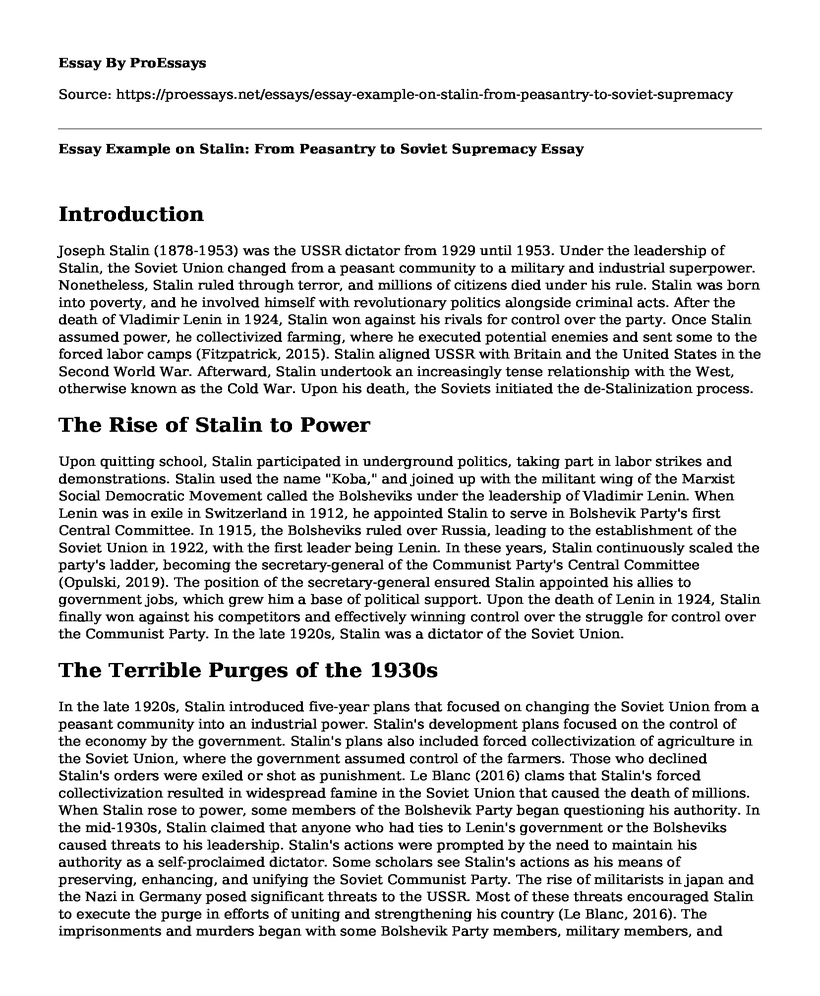Introduction
Joseph Stalin (1878-1953) was the USSR dictator from 1929 until 1953. Under the leadership of Stalin, the Soviet Union changed from a peasant community to a military and industrial superpower. Nonetheless, Stalin ruled through terror, and millions of citizens died under his rule. Stalin was born into poverty, and he involved himself with revolutionary politics alongside criminal acts. After the death of Vladimir Lenin in 1924, Stalin won against his rivals for control over the party. Once Stalin assumed power, he collectivized farming, where he executed potential enemies and sent some to the forced labor camps (Fitzpatrick, 2015). Stalin aligned USSR with Britain and the United States in the Second World War. Afterward, Stalin undertook an increasingly tense relationship with the West, otherwise known as the Cold War. Upon his death, the Soviets initiated the de-Stalinization process.
The Rise of Stalin to Power
Upon quitting school, Stalin participated in underground politics, taking part in labor strikes and demonstrations. Stalin used the name "Koba," and joined up with the militant wing of the Marxist Social Democratic Movement called the Bolsheviks under the leadership of Vladimir Lenin. When Lenin was in exile in Switzerland in 1912, he appointed Stalin to serve in Bolshevik Party's first Central Committee. In 1915, the Bolsheviks ruled over Russia, leading to the establishment of the Soviet Union in 1922, with the first leader being Lenin. In these years, Stalin continuously scaled the party's ladder, becoming the secretary-general of the Communist Party's Central Committee (Opulski, 2019). The position of the secretary-general ensured Stalin appointed his allies to government jobs, which grew him a base of political support. Upon the death of Lenin in 1924, Stalin finally won against his competitors and effectively winning control over the struggle for control over the Communist Party. In the late 1920s, Stalin was a dictator of the Soviet Union.
The Terrible Purges of the 1930s
In the late 1920s, Stalin introduced five-year plans that focused on changing the Soviet Union from a peasant community into an industrial power. Stalin's development plans focused on the control of the economy by the government. Stalin's plans also included forced collectivization of agriculture in the Soviet Union, where the government assumed control of the farmers. Those who declined Stalin's orders were exiled or shot as punishment. Le Blanc (2016) clams that Stalin's forced collectivization resulted in widespread famine in the Soviet Union that caused the death of millions. When Stalin rose to power, some members of the Bolshevik Party began questioning his authority. In the mid-1930s, Stalin claimed that anyone who had ties to Lenin's government or the Bolsheviks caused threats to his leadership. Stalin's actions were prompted by the need to maintain his authority as a self-proclaimed dictator. Some scholars see Stalin's actions as his means of preserving, enhancing, and unifying the Soviet Communist Party. The rise of militarists in japan and the Nazi in Germany posed significant threats to the USSR. Most of these threats encouraged Stalin to execute the purge in efforts of uniting and strengthening his country (Le Blanc, 2016). The imprisonments and murders began with some Bolshevik Party members, military members, and political officials. Later, the purge extended to cover ethnic minorities, scientists, peasants, writers, ordinary citizens, and writers, among others. No one was safe from danger.
Conclusion
Stalin was a dictator, and under his leadership of the Soviet Union, caused increased tensions with other countries. The Cold War is an example of the extent of these tensions and what it meant for Stalin's authority. Essentially, Stalin engaged in the great purges in a bid to unify the Soviet Union and ensure that his position as the Soviet Union was not threatened.
References
Fitzpatrick, S. (2015). On Stalin's Team: The years of living dangerously in Soviet politics. Juncture, 22(3), 248-251. Retrieved from http://dannyreviews.com/h/Stalins_Team.html
Le Blanc, P. (2016). Reflections on the Meaning of Stalinism. Crisis and Critique, 3. Retrieved from http://crisiscritique.org/ccmarch/blanc.pdf
Opulski, R. (2019). Stalinization, de-Stalinization, and re-Stalinization. 1953 behind the "Iron Curtain." The Person and the Challenges. The Journal of Theology, Education, Canon Law and Social Studies Inspired by Pope John Paul II, 9(2), 25-39. Retrieved from http://czasopisma.upjp2.edu.pl/thepersonandthechallenges/article/viewFile/3448/3347
Cite this page
Essay Example on Stalin: From Peasantry to Soviet Supremacy. (2023, Mar 26). Retrieved from https://proessays.net/essays/essay-example-on-stalin-from-peasantry-to-soviet-supremacy
If you are the original author of this essay and no longer wish to have it published on the ProEssays website, please click below to request its removal:
- Essay on Causes of World War II, U.S Adversaries and the Use of Atomic Bombs
- Jonah The Prophet Biographical Essay
- Medea the Play Essay Example
- Paper Example on Beethoven's Symphonies: Exploring Art & Ideas
- Essay Example on Jennifer Doudna: Pioneering CRISPR-Cas9 Genome Engineering Expert
- Paper Example on Erving Goffman: A Canadian-Ukrainian Jew and His Rise to Fame
- Transformative Forces in American History: Commerce, Politics, and Slavery from Colonies to Jacksonian Era







